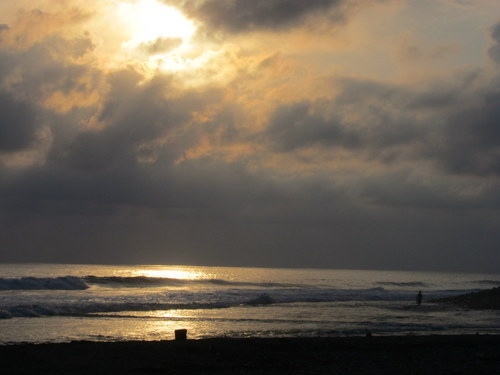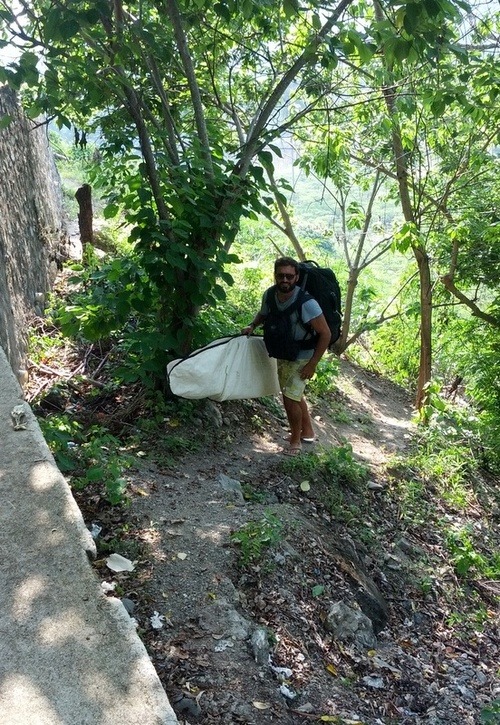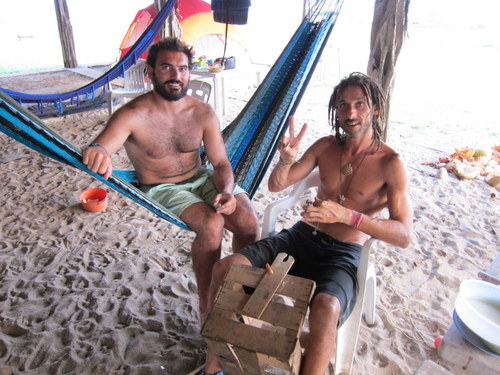The town of La Ticla has about 500 inhabitants, who mostly subsist on farming and fishing. The land is communally owned, a traditional area that can’t be sold off, which means that there is hardly any development. Just the one main camping and cabaña hotel on the beach, and some other smaller scattered accommodations. There are two little shops, a beach bar shack, and a few taco stands. No cell reception, although it’s possible to use the laptop at the gate to access the internet. There aren’t any ATMs in the town, and the nearest one is a good hour’s drive away.
From Pascuales, Tom and I took a bus to Tecoman, then another to La Ticla. The bus cruised along the coastal highway and only stopped at the top of the road to La Ticla, instead of going all the way down. So we had to take our new boards and backpacks for a walk through the blazing afternoon heat. It took about 30 minutes to get down to the town, drenched in sweat.
We stayed for 6 nights, and during that time we met a lot of people as they came and went. A hippy from Spain named Eduardo, a group of Mexican friends and their tag-along Norwegian girl, two guys from England who were driving from Guatemala, American surfer kids, Auzzies, Canadians, a group of French friends who were engineers back in France. The whole spectrum was there. The best part was that there were maximum 30 tourists in the town at any one time, so you really got to know your neighbours and get everyone’s story.
The waves at Ticla were epic. The point break created a rolling left when the south swell came in, and Tom and I were getting awesome rides. Two hours surf in the morning, another two hours in the afternoon, every day. Arms turning to jelly. “Crowded" was 15 people out. For a large portion of the time, we had everything to ourselves, as we’d get up at 7.30am and typically the first hour in the morning was empty.
Surfing Ticla was pretty wild. From the backline, all we could really see was the green mountains and hills, the cliffs, coconut trees and uninhabited beaches for miles in both directions. There were seemingly hundreds of turtles, that constantly popped their heads out of the water for a brief second, before submerging again. Seeing a turtle became very blase, and sometimes they were in the way. We’d have to surf around them. The giant pelicans also enjoyed catching the waves, by hovering just in front of the unbroken swell they could drift right across the point without flapping once.
On one of the days, a huge ray lept about 6 feet out of the water straight up into the air, like a majestic bird, right next to Tom. He justifiably crapped himself. I saw the whole thing and it was incredible. Needle fish would jump out of the water and shoot across the surface like mini rockets, Eduardo told me that one hit a surfer on the side of the face and he had to get surgery. Crazy.
The shore wasn’t much different. Someone found a baby turtle wondering around the campgrounds. Every evening, the sand everywhere would appear to crawl as the hermit crabs emerged and scuttled off towards wherever they go every night. Being a small fishing village, there were always donkeys, horses, cows, pigs and chickens walking around everywhere. Mosquitos, beetles, spiders, midges.
Even though it was off-season, the village was very empty. There were many cabanas that looked like they had been moth-balled. It wasn’t really clear how a few of the businesses stayed open. Maybe through extreme dedication: the lady at the beach bar told me that she slept in the hammock outside, and if we wanted beers we should wake her anytime day or night.




